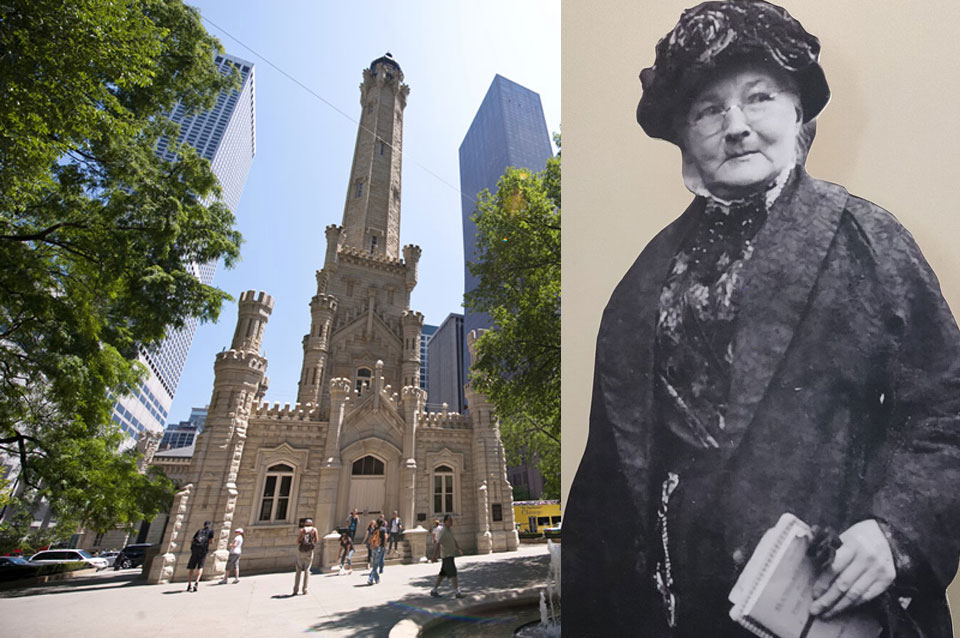
CHICAGO—Famed labor organizer and hell-raiser Mary Harris “Mother” Jones is coming back—as a memorial statue of her—to a prominent place in a city where she raised a lot of hell: Chicago.
And when her statue is erected, after appropriate artistic approvals later this year, it’ll be at an iconic site in the Windy City not far from where Jones began her pro-worker marches after migrating there: The park around the city’s historic Water Tower on North Michigan Avenue.
Indeed, one of the largest marches, of more than 50,000 people, paraded straight down Michigan Avenue in the late 1880s.
“We’ve been waiting to announce this officially for too long,” exulted the leaders of the drive for the statue, officially the Mother Jones “We Shall Rise” monument. “There have some negotiations and some wrinkles . But we did it, indeed,” they said on Jan. 30.
How? By organizing, of course, the Mother Jones Historic Project committee added.
“Chicago’s Water Tower is the most iconic old Chicago site in the city, and one of the most visited. Yet the park around it is small, intimate. This sculpture will signal Chicago is a union town, that immigrants and working class built the city, and that we are part of a tradition of struggle.”
Jones (1837-1930) came to Chicago to help lead the labor struggle there, just before the Great Chicago Fire of 1871. It destroyed most of the South Side, much of the west side and all of downtown and neighborhoods north of the Chicago River—up to the Water Tower.
Jones stayed on in the Windy City, basing herself in Chicago and organizing its workers when she wasn’t campaigning for downtrodden, exploited coal miners downstate, and their union, the United Mine Workers. She’s buried at Mt. Olive, in coal country.
“The Water Tower was being built when Mother Jones returned to Chicago after she lost her husband and children to yellow fever,” the monument committee explained. After the fire, Mother Jones “found a new purpose by becoming part of Chicago’s multi-ethnic immigrant-based labor movement. The site is still a place where protests are launched.
“When asked how she came to identify as an agitator against the conditions of the poor and oppressed workers, she replied: ‘I first began to think of it after the Great Fire of Chicago, when I saw all the relief which had been sent the distressed did not reach the source for which it was meant.’”
The committee is still raising funds for the statue and the landscaping around it. “The sculpture will now represent labor history, women’s history, the history of immigrants, and the long struggle of people before profit. It will be the first sculpture of Mother Jones. It’s long overdue, we say,” the committee declared.
Fittingly, Mine Workers President Cecil Roberts is one of three national union leaders on the organizing and fundraising committee. The other two are Presidents Sara Nelson of the Association of Flight Attendants-CWA and Terry O’Sullivan of the Laborers. Prominent retired AFSCME local labor leader Saul Schneiderman of D.C. disclosed the win in a blog posting.
Roberts, who’s a licensed preacher, often does just that at union meetings. O’Sullivan, who can also produce stemwinders, got his start at the Laborers while helping build one of Chicago’s expressways. And Nelson frequently sounds, and organizes, like Mother Jones.
One notable instance of that came when former Republican Oval Office occupant Donald Trump shut down the federal government, except for “essential” workers such as airline crews, several years ago in a budget dispute with Congress.
When Nelson advocated that air workers, including air traffic controllers, call a general strike—and when New York controllers brought flying to a halt with a mass no-show response–Trump caved to the corporate uproar demanding he settle so planes could fly and commerce could resume. The shutdown ended after 35 days, and Trump didn’t get what he wanted: His racist Mexican Wall.
Nelson sounds like Mother Jones, doesn’t she?
The Mother Jones statue also will be a notable labor sculpture in the nationwide campaign to replace statues of oppressors, primarily slaveholders, with either liberators like Jones or nothing at all.
In Chicago alone, that campaign saw removal of the statue honoring policemen who arrested eight leading labor agitators after someone–nobody knows who–threw a bomb at the end of speeches in Haymarket Square in favor of the eight-hour day on May 4, 1886. Officers fired, and unionists died. That statue was in front of the city’s police headquarters for decades.
The eight unionists, most of them German-born Socialists, were convicted after a mockery of a trial. Three were hung just weeks later. One committed suicide in prison the night before. Later, Illinois’s first pro-worker Gov. John Peter Altgeld (D), pardoned the other four due to the giant miscarriage of justice.
And in recent years, the country awoke to extermination of Native Americans—decimation which began after Christopher Columbus re-“found” the continent in 1492 and the Spanish colonized the Americas. So in Chicago, the city removed a statue of Columbus located at South Michigan Avenue and Jackson Boulevard, before a crowd threatened to tear it down.










